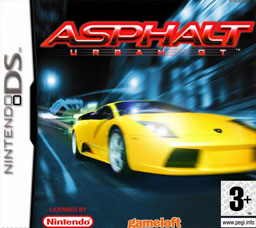Asphalt: Urban GT
2004 video game From Wikipedia, the free encyclopedia
Asphalt: Urban GT is a 2004 arcade-style racing video game developed and published by Gameloft, known as the first title of the Asphalt series. It was released in November 2004[1][2] for the Nokia N-Gage and the Nintendo DS,[3] making it one of the Nintendo DS launch titles. Mobile phone versions on J2ME and BREW were also released.
| Asphalt: Urban GT | |
|---|---|
 European cover art featuring the Lamborghini Murciélago | |
| Developer(s) | Gameloft |
| Publisher(s) | |
| Director(s) | |
| Producer(s) | Philippe Laurens |
| Designer(s) | Guillaume Descamps, Stanislas Dewavrin |
| Programmer(s) | David Nicolier |
| Series | Asphalt |
| Platform(s) | N-Gage Nintendo DS J2ME (Java 2 Micro Edition) BREW |
| Release | N-Gage
J2ME
|
| Genre(s) | Racing |
| Mode(s) | Single player, multiplayer |
The game features manufacturer licensed cars and takes place in locations modeled after real-world counterparts. Gameplay features a nitro mechanic and allows drifting, and alongside standard races against opponents there are also modes such as cop chases.[4] The DS version has support for wireless multiplayer with up to four opponents.[4] Asphalt: Urban GT received mixed to favorable reviews; it was succeeded by Asphalt: Urban GT 2 in 2005.
Gameplay

Asphalt: Urban GT sports nine tracks modelled after real-world locations such as Paris, New York City, Miami, Las Vegas, Cuba, Bogota, Chernobyl, Hong Kong and Texas Motor Speedway. The game's 23 cars are licensed from 14 real manufacturers such as Lamborghini, Hummer, Volkswagen, Nissan, Ford (Shelby), Audi, Aston Martin, Jaguar, Lotus, Morgan, TVR, Chevrolet, Saleen, and others including some of the fictional in-game manufacturers, and can be enhanced with over 30 add-ons. Game modes include instant play, road challenge, free race, time attack, and cop chase. In cop chase, the player takes the role of the police attempting to arrest the other racers.[5]
The game takes advantage of the DS's support for 3D graphics, while showing unaccelerated N-Gage's power to match DS's graphics, showing the action from three camera angles. The bottom screen of the DS is utilized to provide strategic tips and player info.
Reception
| Aggregator | Score | ||
|---|---|---|---|
| DS | mobile | N-Gage | |
| GameRankings | 62%[6] | 67%[7] | 72%[8] |
| Metacritic | 60/100[9] | N/A | 76/100[10] |
| Publication | Score | ||
|---|---|---|---|
| DS | mobile | N-Gage | |
| Electronic Gaming Monthly | 6/10[11] | N/A | N/A |
| Eurogamer | 3/10[12] | N/A | N/A |
| Famitsu | 27/40[13] | N/A | N/A |
| GamePro | N/A | N/A | |
| GameRevolution | C−[15] | N/A | N/A |
| GameSpot | 7.5/10[4] | 8.2/10[16] | 7.5/10[17] |
| GameSpy | N/A | N/A | |
| GameZone | 7.9/10[19] | N/A | N/A |
| IGN | 5.5/10[20] | 7.5/10[21] | N/A |
| Nintendo Power | 3.5/5[22] | N/A | N/A |
Reception
The N-Gage version received "favorable" reviews, while the DS version received "mixed" reviews, according to video game review aggregator Metacritic.[9][10] In Japan, Famitsu gave the latter version a score of one six and three sevens for a total of 27 out of 40.[13]
It received a runner-up position in GameSpot's 2004 "Best N-Gage Game" award category, losing to Colin McRae Rally 2005.[23]
References
External links
Wikiwand - on
Seamless Wikipedia browsing. On steroids.
